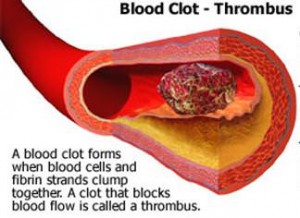You may not know it but if you are over the age of 50 the greatest threat to your health is the formation of abnormal blood clots in your arteries and veins. One in every three Americans deal with blood clot disorders in their lifetime. And eighty percent of people with diabetes die of blood clot-related issues.
A blood blot consists of a “clump” of blood-born particles that have become “stuck” together inside a blood vessel.
The most common form of heart attack occurs when a blood clot (thrombus) blocks a coronary artery that feeds your heart muscle. The leading cause of stroke occurs when a blood clot occludes, or obstructs, an artery supplying blood to your brain. Formation of vascular blood clots is also a leading cause of death in cancer patients because cancer cells create conditions that favor clotting.
While normal blood clots are a natural part of healing, abnormal arterial and venous blood clots are a significant cause of death and disability (Mannucci 2011).
The most effective means of blood clot management is prevention. Experts say there are ways you can prevent blood clots which include:
1) Move it
When you’re stuck in the same position for a long time, blood can pool in your legs, setting the stage for a clot. Every one to two hours, get up and walk around, whether you’re at your desk or on a long car or plane ride. (Contracting your leg muscles while seated can help, too.)
If your legs must be immobile for a week or longer—whether you’re in a cast or on bed rest during pregnancy—talk to your doc about preventing DVT(Deep Vein Thrombosis).
2) Live Healthy
If you smoke, you should quit. Drink a lot of water-staying hydrated can lower your risks of blood clots.
3) Be smart with meds
Taking the pill increases your DVT risks, which means it may not be the right birth control choice if you have another risk factor (a genetic predisposition to clotting or a family history of DVT, or if you smoke).
4) Know the signs
Look out for pain, swelling, and redness or discoloration in one leg; you may experience a feeling of warmth on the skin at the affected area. Sudden unexplained shortness of breath is the most common warning sign the the blood clot has traveled to the lungs.
5)Be proactive
If you have an injury or are going for surgery, talk to your doctor about preventing DVT (Deep Vein Thrombosis). If you experience any of the above symptoms, go to the nearest ER. Be sure to tell the nurse if you’re on birth control pills, if you’ve been on a long plane ride, or if you’ve had surgery or an injury within the previous right weeks.




